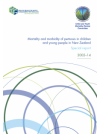Pertussis (also known as whooping cough) can be very serious, even fatal. This report demonstrates that the impact of the illness is not distributed equitably among New Zealand children and young people.
Key Results
Over the last 13 years (during 2002–14) for which data are available in New Zealand for children and young people aged under 25 years:
• there were eight deaths attributable to pertussis. Seven of these deaths were in infants under 3 months of age, who had either no or inadequate protection against pertussis1
• there were just under 13,000 notified cases of confirmed, probable or suspected pertussis – an average of 992 cases per year
• there were 1515 hospital admissions attributable to pertussis. Over three-quarters of these admissions were in infants under 6 months of age who had either no or inadequate protection against pertussis
• infants aged under 3 months had the highest notification rate (407.9 per 100,000) and the highest hospitalisation rate (468.2 per 100,000) for pertussis
• when examined by ethnicity, Ma- ori and Pacific infants, children and young people were significantly more likely to be hospitalised with pertussis than non-Ma- ori/non-Pacific infants. Ethnic inequities were particularly marked for both Ma- ori and Pacific infants aged under 3 months of age, who were an estimated 2.7 and 3.6 times more likely to be hospitalised for pertussis compared with non-Ma- ori/non-Pacific infants respectively.
The Child and Youth Mortality Review Committee (CYMRC) notes:
• maternal immunisation with pertussis booster vaccinations is protective for infants under 3 months of age
• maternal immunisation with pertussis booster vaccinations is safe for pregnant women and their infants
• increasing uptake of antenatal pertussis booster vaccinations among pregnant women in the third trimester requires increasing awareness of the vaccine among health care providers and pregnant women. A wide range of educational resources targeting pregnant women, lead maternity carers and primary health care providers are needed to achieve this
• having local- and national-level systems in place can help both improve coverage and record the uptake of pertussis booster vaccinations among pregnant women. Systems in primary care settings that recall pregnant women for the vaccination in their third trimester can help increase uptake. Uptake of the vaccination by pregnant women should also be recorded at a national level and transferred onto the infant’s immunisation record at birth
• barriers to immunisation service access should be addressed through national policies that aim to achieve equitable and on-time immunisation coverage by providing pertussis booster vaccinations in a broad range of settings.

